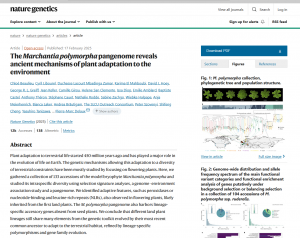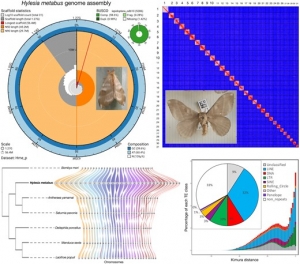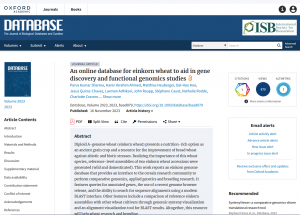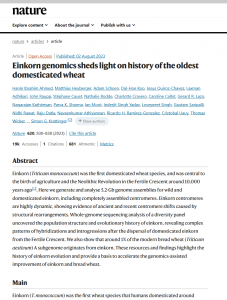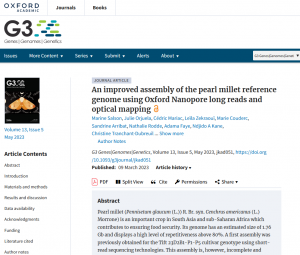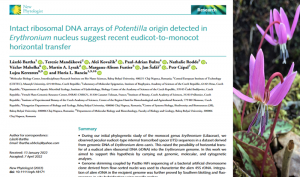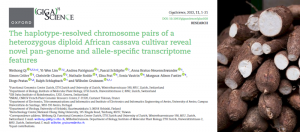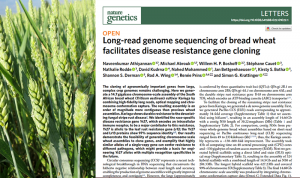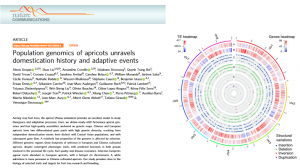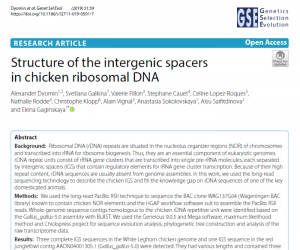
Arrival date : 2011
Status : Research Assistant
Roles :
Last completed degree : Master in Reproduction biology and development (2006 - Paris V)
Professional experiences :
- Project coordinator
- Project Partner
- CNRGV implications: Reindeer BAC library construction and screening = identification of BAC clones carrying the PRNP polymorphisms and Optical map production
- CNRGV's responsible: Nathalie Rodde
- Funding: SA INRA department
Developing methods for identifying the (food) risks associated with emerging prions responsible for Chronic Wasting Disease in Europe
Something went wrong when connecting to PubMed API.
Click here to access to the publication on PubMed website

Developing methods for identifying the (food) risks associated with emerging prions responsible for Chronic Wasting Disease in Europe
The main objective of this project is to develop the first tools dedicated to European CWD prions, in terms of detection in tissues from infected animals and characterization of the risks for human health.
Read more
The main objective of this project is to develop the first tools dedicated to European CWD prions, in terms of detection in tissues from infected animals and characterization of the risks for human health.
This relies on:
- the identification of PRNP polymorphisms potentially associated with genetic susceptibility / resistance to CWD in European cervid populations and of the relative capacity of the associated PrP protein to be converted into CWD prions,
- the development of transgenic mouse models expressing the PRNP polymorphisms associated with the highest susceptibility,
- the development of cell-free assays able to detect minute amounts of European CWD prions in tissues and fluids,
- the experimental modelling with humanized mouse models of the risk posed by European CWD prions for human.
INRA ENVT UMR1225
23 Chemin des Capelles
BP 87614 31 076
Toulouse Cedex 3 - France
| INRA VIM - UR892
Domaine de Vilvert | INRA GABI UMR1313
Domaine de Vilvert |
Comprehensive annotation of olfactory and gustatory receptor genes and transposable elements revealed their evolutionary dynamics in aphids
Something went wrong when connecting to PubMed API.
Click here to access to the publication on PubMed website
Interplay between large low-recombining regions and pseudo-overdominance in a plant genome
Something went wrong when connecting to PubMed API.
Click here to access to the publication on PubMed website
Transposable element accumulation drives genome size increase in Hylesia metabus (Lepidoptera: Saturniidae), an urticating moth species from South America
Something went wrong when connecting to PubMed API.
Click here to access to the publication on PubMed website
The Marchantia polymorpha pangenome reveals ancient mechanisms of plant adaptation to the environment
Something went wrong when connecting to PubMed API.
Click here to access to the publication on PubMed website
Genome assembly of a diversity panel of Chenopodium quinoa
Something went wrong when connecting to PubMed API.
Click here to access to the publication on PubMed website
Transposable element accumulation drives genome size increase in Hylesia metabus (Lepidoptera: Saturniidae), an urticating moth species from South America
Something went wrong when connecting to PubMed API.
Click here to access to the publication on PubMed website
An online database for einkorn wheat to aid in gene discovery and functional genomics studies
Something went wrong when connecting to PubMed API.
Click here to access to the publication on PubMed website
Einkorn genomics sheds light on history of the oldest domesticated wheat
Something went wrong when connecting to PubMed API.
Click here to access to the publication on PubMed website
An improved assembly of the pearl millet reference genome using Oxford Nanopore long reads and optical mapping
Something went wrong when connecting to PubMed API.
Click here to access to the publication on PubMed website
The genomics of linkage drag in inbred lines of sunflower
Something went wrong when connecting to PubMed API.
Click here to access to the publication on PubMed website
A MITE insertion abolishes the AP3-3 self-maintenance regulatory loop in apetalous flowers of Nigella damascena
Something went wrong when connecting to PubMed API.
Click here to access to the publication on PubMed website
Intact ribosomal DNA arrays of Potentilla origin detected in Erythronium nucleus suggest recent eudicot-to-monocot horizontal transfer
Something went wrong when connecting to PubMed API.
Click here to access to the publication on PubMed website
The haplotype-resolved chromosome pairs of a heterozygous diploid African cassava cultivar reveal novel pan-genome and allele-specific transcriptome features
Something went wrong when connecting to PubMed API.
Click here to access to the publication on PubMed website
Long-read genome sequencing of bread wheat facilitates disease resistance gene cloning
Something went wrong when connecting to PubMed API.
Click here to access to the publication on PubMed website
Population genomics of apricots unravels domestication history and adaptive events
Something went wrong when connecting to PubMed API.
Click here to access to the publication on PubMed website
Structure of the intergenic spacers in chicken ribosomal DNA
Something went wrong when connecting to PubMed API.
Click here to access to the publication on PubMed website
Gene Duplication in the Sugarcane Genome: A Case Study of Allele Interactions and Evolutionary Patterns in Two Genic Regions
Something went wrong when connecting to PubMed API.
Click here to access to the publication on PubMed website
A gene-rich fraction analysis of the Passiflora edulis genome reveals highly conserved microsyntenic regions with two related Malpighiales species
Something went wrong when connecting to PubMed API.
Click here to access to the publication on PubMed website
Genome-wide identification of the mutation underlying fleece variation and discriminating ancestral hairy species from modern woolly sheep.
Something went wrong when connecting to PubMed API.
Click here to access to the publication on PubMed website
Genome-wide identification of the mutation underlying fleece variation and discriminating ancestral hairy species from modern woolly sheep.
Demars J, Cano M, Drouilhet L, Plisson-Petit F, Bardou P, Fabre S, Servin B, Sarry J, Woloszyn F, Mulsant P, Foulquier D, Carriere F, Aletru M, Rodde N, Cauet S, Bouchez O, Pirson M, Tosser-Klopp G, Allain D.
Journal: Molecular Biology and Evolution
DOI: 34: 1722-1729.
Read more
Demars J, Cano M, Drouilhet L, Plisson-Petit F, Bardou P, Fabre S, Servin B, Sarry J, Woloszyn F, Mulsant P, Foulquier D, Carriere F, Aletru M, Rodde N, Cauet S, Bouchez O, Pirson M, Tosser-Klopp G, Allain D.
Journal: Molecular Biology and Evolution
DOI: 34: 1722-1729.
Abstract
The composition and structure of fleece variation observed in mammals is a consequence of a strong selective pressure for fiber production after domestication. In sheep, fleece variation discriminates ancestral species carrying a long and hairy fleece from modern domestic sheep (Ovis aries) owning a short and woolly fleece. Here, we report that the “woolly” allele results from the insertion of an antisense EIF2S2 retrogene (called asEIF2S2) into the 3′ UTR of the IRF2BP2 gene leading to an abnormal IRF2BP2 transcript. We provide evidence that this chimeric IRF2BP2/asEIF2S2 messenger 1) targets the genuine sense EIF2S2 RNA and 2) creates a long endogenous double-stranded RNA which alters the expression of both EIF2S2 and IRF2BP2 mRNA. This represents a unique example of a phenotype arising via a RNA-RNA hybrid, itself generated through a retroposition mechanism. Our results bring new insights on the sheep population history thanks to the identification of the molecular origin of an evolutionary phenotypic variation.
Link: https://academic.oup.com/mbe/article/34/7/1722/3091105
The chloroplast genome of Passiflora edulis (Passifloraceae) assembled from long sequence reads: structural organization and phylogenomic studies in Malpighiales
Something went wrong when connecting to PubMed API.
Click here to access to the publication on PubMed website
The chloroplast genome of Passiflora edulis (Passifloraceae) assembled from long sequence reads: structural organization and phylogenomic studies in Malpighiales
Front. Plant Sci. 8:334. DOI: 10.3389/fpls.2017.00334
Read more
Authors :
Cauz Santos LA, Freitas Munhoz C, Rodde N, Cauet S, Azevedo Santos A, Alves Penha H, Carnier Dornelas M, de Mello Varani A, Conde Xavier Oliveira G, Bergès H, Carneiro Vieira ML (2017)
Front. Plant Sci. 8:334. DOI: 10.3389/fpls.2017.00334
Abstract :
The family Passifloraceae consists of some 700 species classified in around 16 genera. Almost all its members belong to the genus Passiflora. In Brazil, the yellow passion fruit (Passiflora edulis) is of considerable economic importance, both for juice production and consumption as fresh fruit. The availability of chloroplast genomes (cp genomes) and their sequence comparisons has led to a better understanding of the evolutionary relationships within plant taxa. In this study, we obtained the complete nucleotide sequence of the P. edulis chloroplast genome, the first entirely sequenced in the Passifloraceae family. We determined its structure and organization, and also performed phylogenomic studies on the order Malpighiales and the Fabids clade. The P. edulis chloroplast genome is characterized by the presence of two copies of an inverted repeat sequence (IRA and IRB) of 26,154 bp, each separating a small single copy region of 13,378 bp and a large single copy (LSC) region of 85,720 bp. The annotation resulted in the identification of 105 unique genes, including 30 tRNAs, 4 rRNAs, and 71 protein coding genes. Also, 36 repetitive elements and 85 SSRs (microsatellites) were identified. The structure of the complete cp genome of P. edulis differs from that of other species because of rearrangement events detected by means of a comparison based on 22 members of the Malpighiales. The rearrangements were three inversions of 46,151, 3,765 and 1,631 bp, located in the LSC region. Phylogenomic analysis resulted in strongly supported trees, but this could also be a consequence of the limited taxonomic sampling used. Our results have provided a better understanding of the evolutionary relationships in the Malpighiales and the Fabids, confirming the potential of complete chloroplast genome sequences in inferring evolutionary relationships and the utility of long sequence reads for generating very accurate biological information.
Long Read Sequencing Technology to Solve Complex Genomic Regions Assembly in Plants.
Something went wrong when connecting to PubMed API.
Click here to access to the publication on PubMed website
Long Read Sequencing Technology to Solve Complex Genomic Regions Assembly in Plants.
Journal of Next Generation Sequencing & Applications.
Read more
Authors :
Arnaud Bellec, Audrey Courtial, Stephane Cauet, Nathalie Rodde, Sonia Vautrin, Genseric Beydon, Nadege Arnal, Nadine Gautier, Joelle Fourment, Elisa Prat, William Marande, Yves Barriere and Helene Berges.
Journal of Next Generation Sequencing & Applications.
Abstract :
Background:
Numerous completed or on-going whole genome sequencing projects have highlighted the fact that obtaining a high quality genome sequence is necessary to address comparative genomics questions such as structural variations among genotypes and gain or loss of specific function. Despite the spectacular progress that has been made in sequencing technologies, obtaining accurate and reliable data is still a challenge, both at the whole genome scale and when targeting specific genomic regions. These problems are even more noticeable for complex plant genomes. Most plant genomes are known to be particularly challenging due to their size, high density of repetitive elements and various levels of ploidy. To overcome these problems, we have developed a strategy to reduce genome complexity by using the large insert BAC libraries combined with next generation sequencing technologies.
Results:
We compared two different technologies (Roche-454 and Pacific Biosciences PacBio RS II) to sequence pools of BAC clones in order to obtain the best quality sequence. We targeted nine BAC clones from different species (maize, wheat, strawberry, barley, sugarcane and sunflower) known to be complex in terms of sequence assembly. We sequenced the pools of the nine BAC clones with both technologies. We compared assembly results and highlighted differences due to the sequencing technologies used.
Conclusions:
We demonstrated that the long reads obtained with the PacBio RS II technology serve to obtain a better and more reliable assembly, notably by preventing errors due to duplicated or repetitive sequences in the same region.
Link :
Something went wrong when connecting to PubMed API.
Click here to access to the publication on PubMed website
Something went wrong when connecting to PubMed API.
Click here to access to the publication on PubMed website
Something went wrong when connecting to PubMed API.
Click here to access to the publication on PubMed website
Something went wrong when connecting to PubMed API.
Click here to access to the publication on PubMed website
Something went wrong when connecting to PubMed API.
Click here to access to the publication on PubMed website




